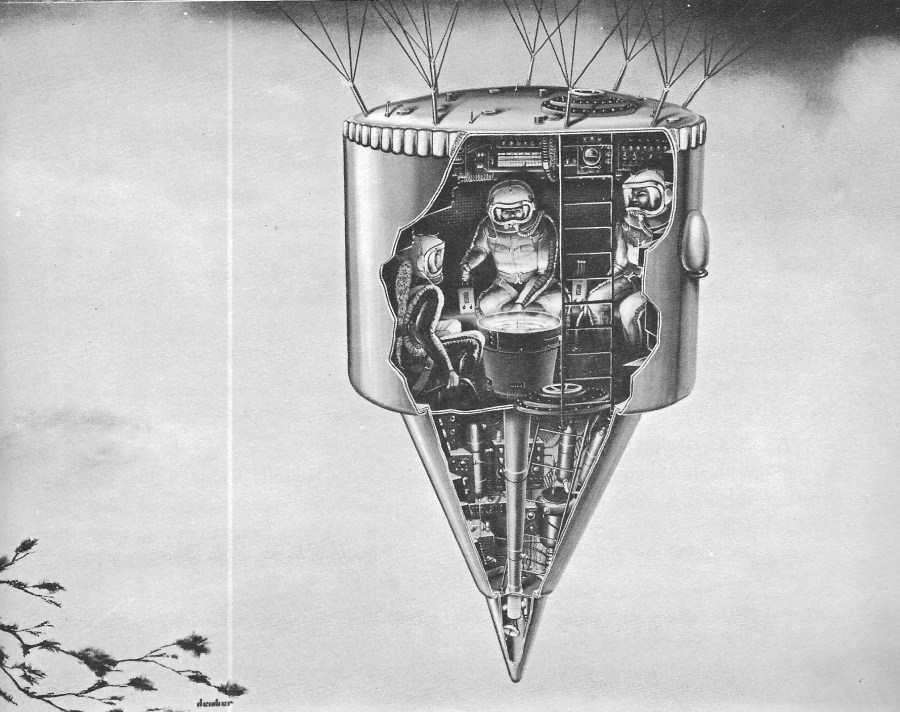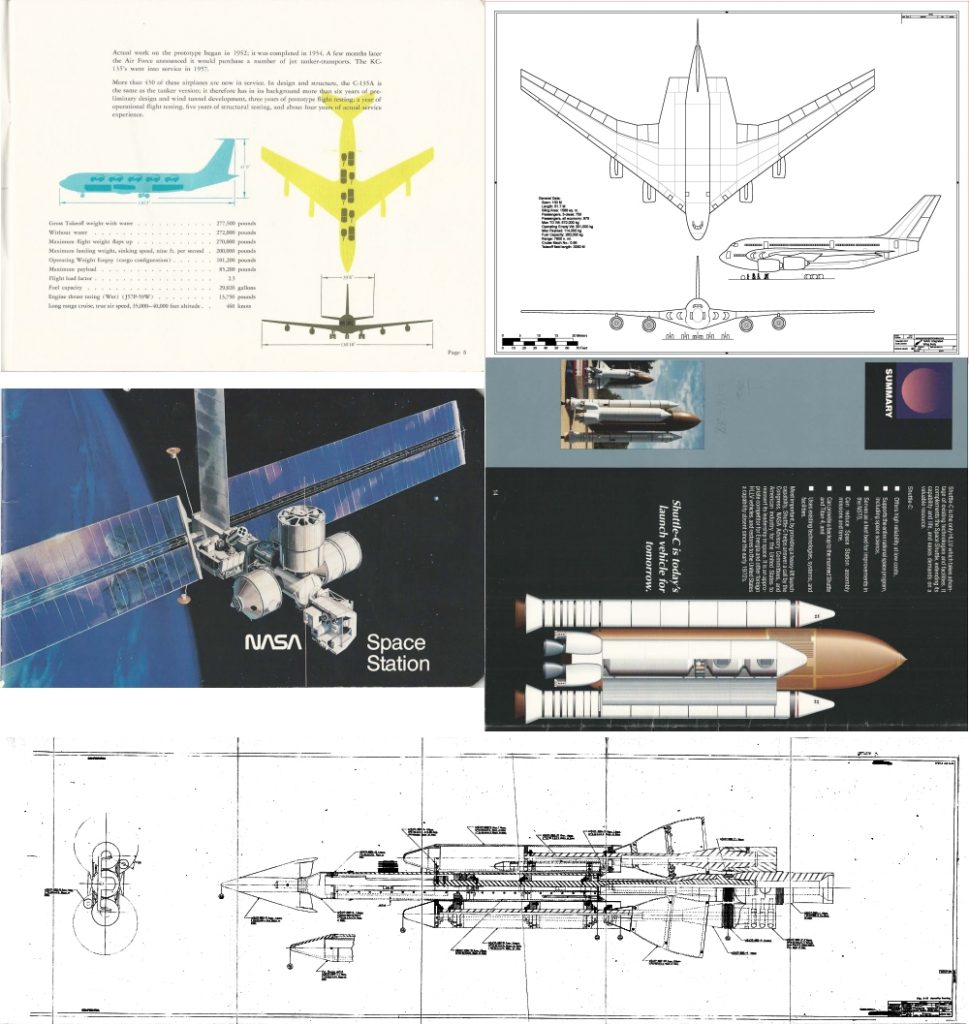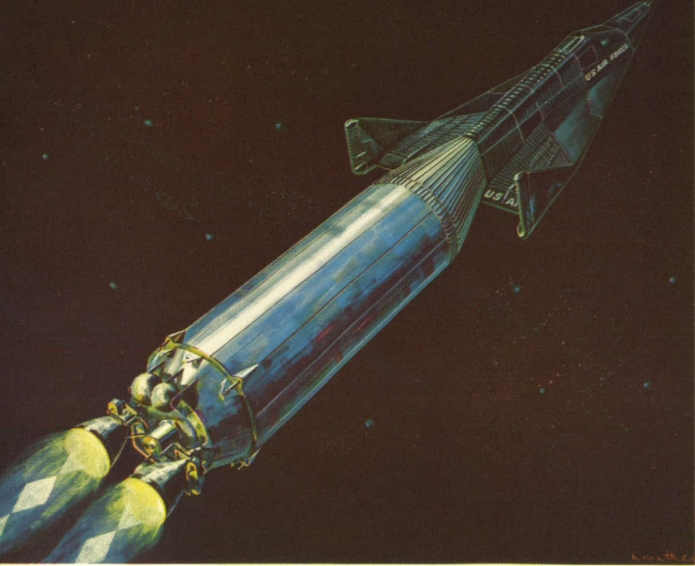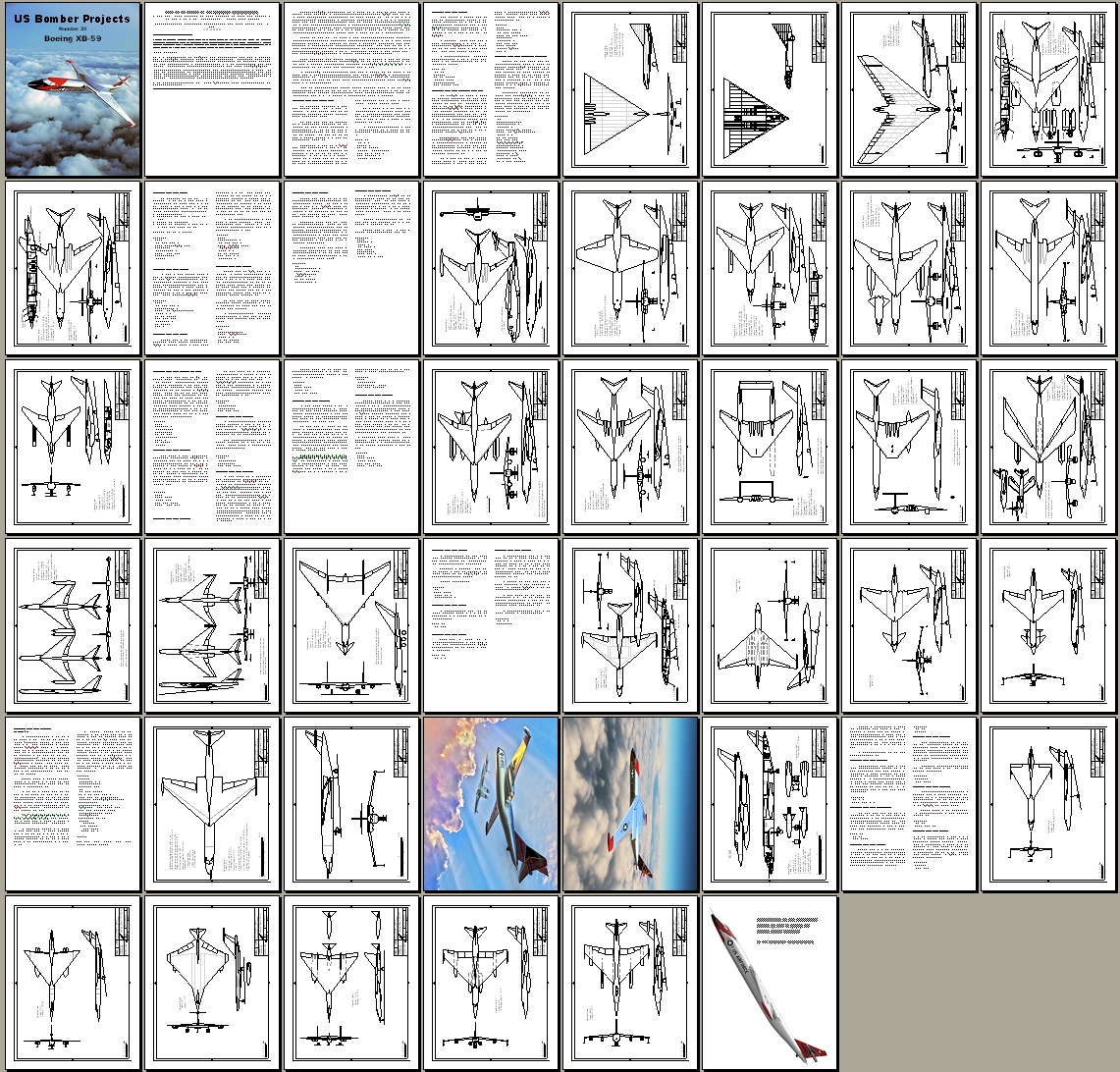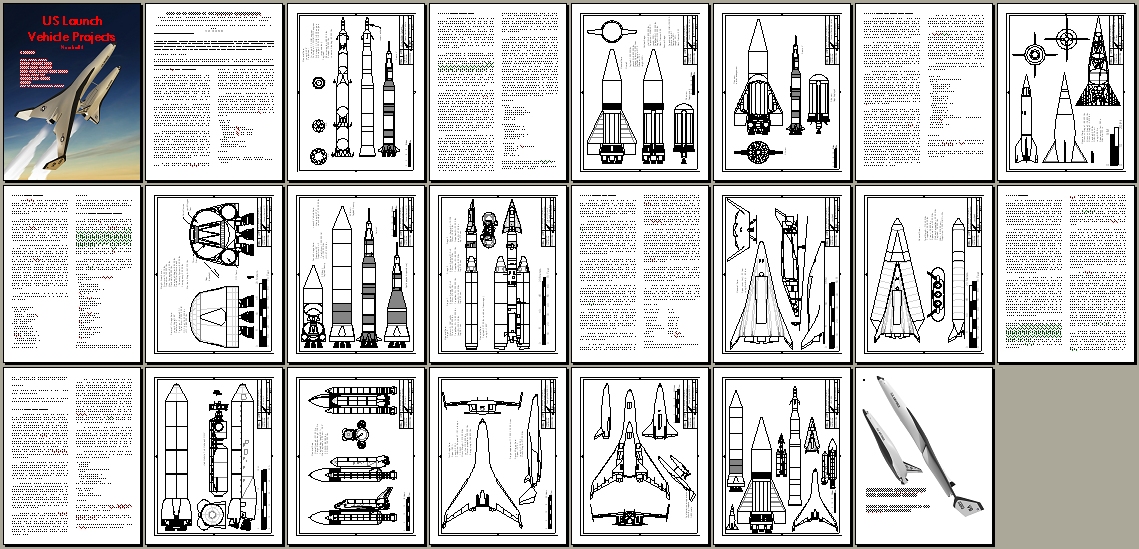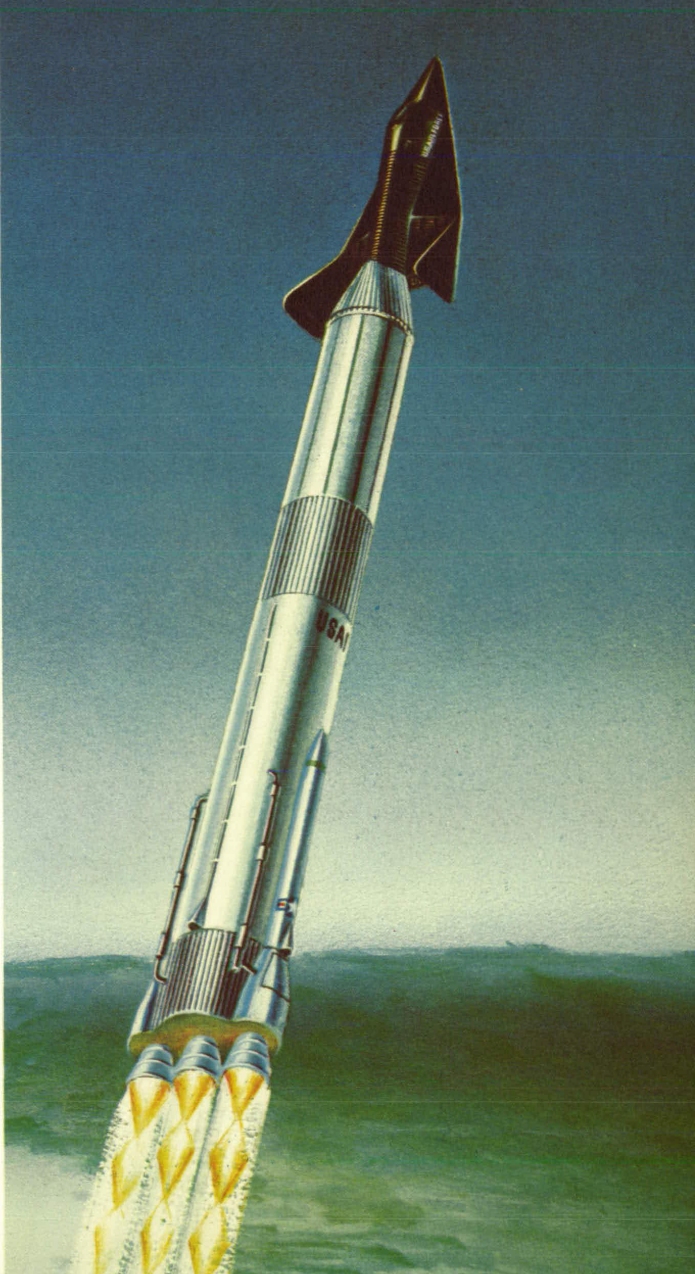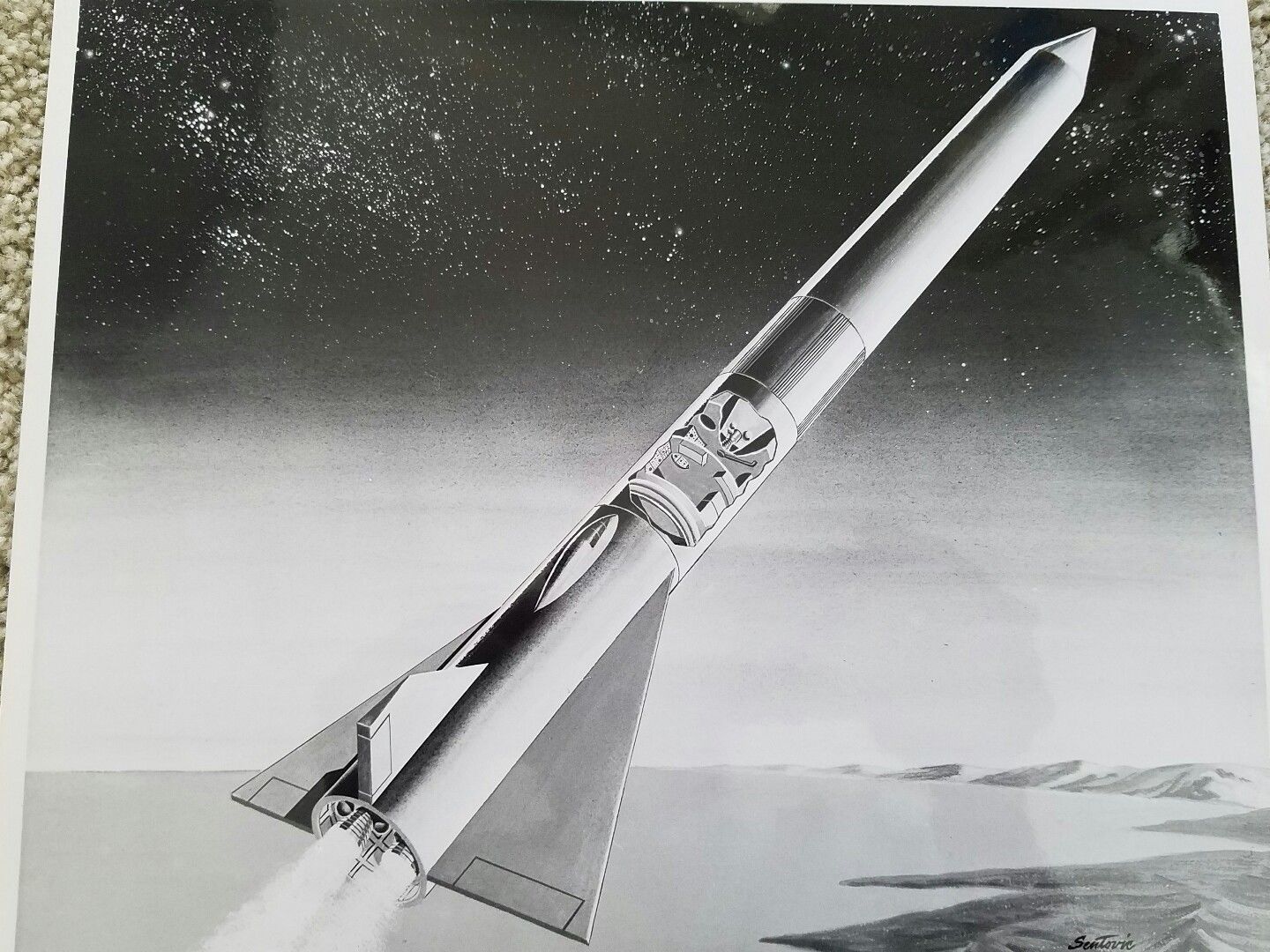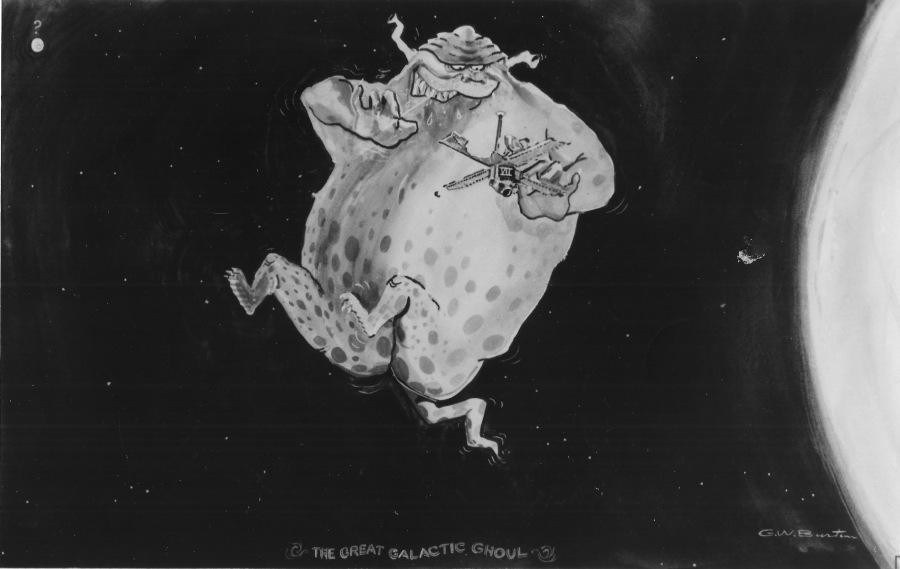An apparently pre-Mercury “space capsule” design from Rocketdyne. I am somewhat dubious, though… I suspect it might be less “space capsule” than “high altitude capsule.” Nothing about it screams “re-entry vehicle;” rather it look like something that might have been hauled to the edge of space by a large balloon. The pressure suits worn by the occupants look like something to be worn by a U-2 pilot; there sure is a whole lot of wasted volume in there and it would be odd for a capsule meant to operate in zero-g to have a ladder in it.
Posted to a NASA Flickr page is this illustration of a 1984 space station concept:
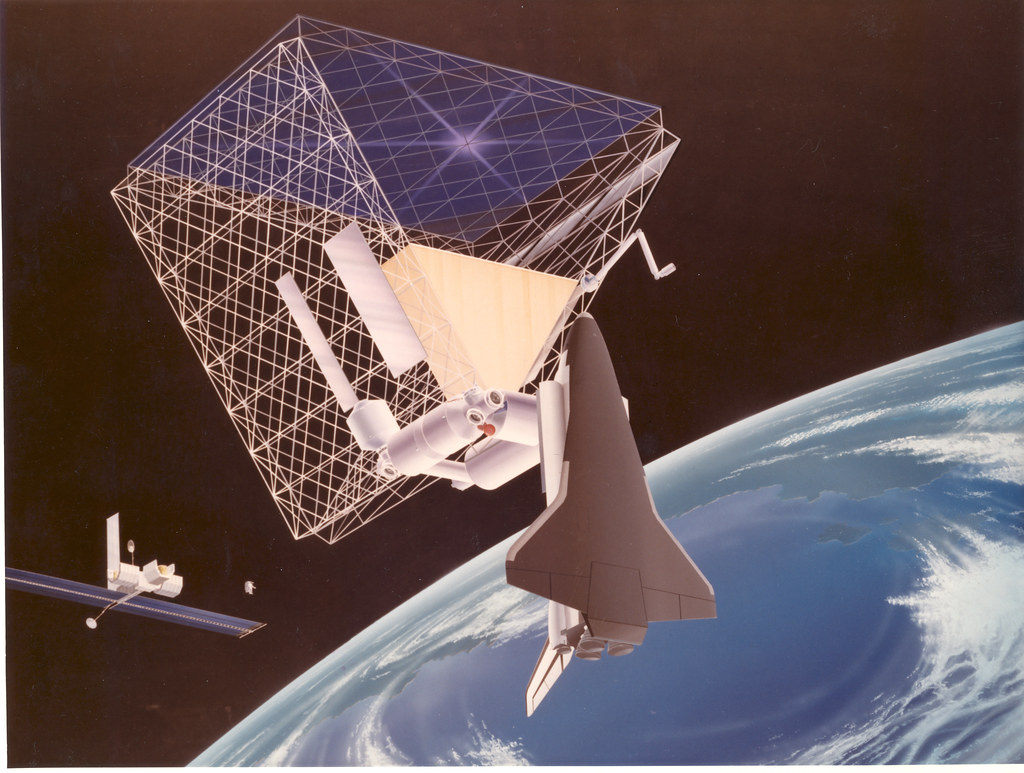
This would probably be a very heavy station for the volume and usable surface area provided. However, once that truss structure is in place, it seems like it would be possible to keep adding on to it without overly stressing the structure, with the possible result of a very capable station. It should also be possible to keep tacking on new truss elements.
The design would necessarily keep most of the station elements shadowed by the solar arrays.
Got them done a little early this time, so here’s a review of what the APR Patrons will be receiving:
Patrons will receive:
A proposal brochure on the C-135A cargo transport
A brochure about the Shuttle-C
A well illustrated NASA-produced booklet from the mid 1980’s describing the space station as them conceived
A large format diagram showing a wind tunnel model of the Titan III/Dyna Soar
A CAD diagram of the ca. 2001 Russian TsAGI Integrated Wing Body large passenger transport jetliner
If these are of interest, please consider signing on to the APR Patreon.
I have a number of new aerospace cyanotype blueprints available. Until I can repave the catalog page, I have slapped together a PDF catalog of the new items. Until Wednesday, I’m making these new 12X18 prints, as well as the earlier 12X18 prints, available. The earlier 12X18s are viewable HERE. The new items are in the following PDF file:
If any are of interest, Paypal to the email address in the PDF file, and add a note in the order which items you want…. AND what your mailing address is (PayPal doesn’t automatically add the address to payments like this).
After Wednesday the prints will be again unavailable for a little bit while I retool and work on some things.
UPDATE: over for now. After some retooling I hope to have all the cyanotypes, small and large old and new, available for regular sale.
Some fellers are working on nano-satellite “kits,” and have set up a Kickstarter to fund the project. The end result will be Raspberry Pi computer powered little satellite simulators that will – at the upper end – apparently be launched atop sounding-type rockets. The people behind this project had the good sense to have me produce a 12X18 cyanotype blueprint of a diagram of the original Sputnik satellite to serve as one of the funding rewards.
The Kickstarter page is currently a bit lean on details, but I’m told they’re going to flesh it out in coming days. Take a look:
Sputnik CreatorSat – build your own satellite


Another rare piece of early Dyna Soar color art. This one shows the Dyna Soar heading to space atop the centaur upper stage of an Atlas booster. And if you think you are seeing corrugations on the back of the spaceplane, you are correct. At this stage in the design process the Dyna Soar *did* have some fairly massive, un-aerodynamic corrugations, and for the same reason why the SR-71 has corrugations on the wing: to allow for thermal expansion. Why exactly the Boeing Dyna Soar corrugations run crossways to the airflow, I’m a little unclear on. Terrible aerodynamics, but I imagine that’s just the way the structure wanted to flex.
The corrugations rarely appear on the usually simple diagrams you see of early Dyna Soar configurations, but they were there on full-scale mockups.
Now available: two new US Aerospace Projects issues. Cover art was provided by Rob Parthoens, www.baroba.be
US Bomber Projects #20:XB-59 Special
US Bomber Projects #20 is now available (see HERE for the entire series). Issue #20 collects all the previously published articles and diagrams of the XB-59 antecedent designs and updates them. Additionally, more antecedent designs have been included as well as several designs that followed along after the XB-59. The biggest USXP publication yet!
USBP 20 includes twenty nine unique aircraft concepts (the usual issue of USXP has eight designs) from Boeing Models 484 and 701 showing how Boeing evolved the XB-59, their competitor to the Convair B-58 “Hustler.” Beginning with subsonic flying wings, the concept saw concepts both conventional and unconventional before eventually settling on Model 701-299-1, the final XB-59 design. This issue includes a half dozen Model 701 designs that followed along after the cancellation of the XB-59 program.
USBP #20 can be downloaded as a PDF file for only $8.50:
——–
US Launch Vehicle Projects #04
US Launch Vehicle Projects #04 is now available (see HERE for the entire series). Issue #04 includes:
- Space Carrier Vehicle: A US Army lunar rocket with 8 F-1 engines
- Convair Reusable Helios: A stage-and-a-half monster with a gas core nuclear engine
- Boeing Model 896-111: A 1980’s two stage transatmospheric vehicle
- Project RAND Satellite Rocket 3-Stage: A 1947 satellite launcher
- Convair Saturn V-R: An idea on how to make a fully reusable Saturn V first stage
- Lockheed STAR Clipper: A 1968 stage-and-a-half lifting body Space Shuttle
- Shuttle-C: The Shuttle derived vehicle design that came closest to being built
- Titan III Growth/156-inch boosters: A more powerful version of the Titan III for Dyna Soar launch
USLP #04 can be downloaded as a PDF file for only $4.25:
——–
Also recommended, these previous Specials:
US Bomber Projects #14: System 464L Special
USBP#14 brings together the competitors to Weapon System 464L, the first major effort in the Dyna Soar program. These designs were previously shown individually in prior issues of USBP; here they are brought together, with some updates, as well as a few extra diagrams and a section of diagrams formatted for 11X17 printing. This issue includes info and diagrams of the Lockheed, Republic, General Dynamics, McDonnell, Boeing, Douglas, Northrop, North American and Martin-Bell entries as well as their various booster systems. Also included are detailed diagrams of the ultimate Dyna Soar design, the 2050E.
USBP#14 can be purchased for downloading for the low, low price of $6.25.
US Bomber Projects #16: The B-52 Evolution Special
Boeing Model 444 A: A late war turboprop heavy bomber
Boeing Model 461: An early postwar turboprop heavy bomber
Boeing Model 462: A large six-turboprop ancestor of the B-52
Boeing Model 462-5: A six-turboprop B-52 ancestor
Boeing Model 464-17: 1946 four-turboprop strategic bomber, a step toward the B-52
Boeing Model 464-18: a reduced-size version of the 464-17 turboprop strategic bomber
Boeing Model 464-25: a modification of the 464-17 turboprop bomber with slightly swept wings, among other changes
Boeing Model 464-27: a slightly-swept turboprop B-52 progenitor
Boeing Model 464-33-0: A turboprop B-52 predecessor
Boeing Model 464-34-3: A turboprop B-52 predecessor
Boeing Model 464-40: The first all-jet-powered design in the quest for the B-52
Boeing Model 464-40: The first all-jet-powered design in the quest for the B-52
Boeing Model 464-046: A six-engined B-52 predecessor
Boeing Model 464-49: The penultimate major design in the development of the B-52
Fairchild M-121:A highly unconventional canard-biplane
Convair B-60: A swept-wing turboprop-powered derivative of the B-36
Douglas Model 1211-J: An elegant turboprop alternative to the B-52
With additional diagrams of the B-47, XB-52 and B-52B
USBP#16 can be purchased for downloading for the low, low price of $6.25.

A rare piece of color art of an early Dyna Soar being lofted atop an Atlas/Centaur. Color artwork of the Dyna Soar was created in some considerable abundance, but it was mostly reproduced in B&W, and its sadly rare for even those B&W reports to have been printed well, rarer still for them to have been scanned or copied well.
Recently on ebay were a set of 8X10 glossies, vintage Convair artwork depicting early spacecraft and launch vehicle concepts. I had my bid in… and was sniped in the last few seconds. Oh well. Anyway, one of the more interesting images was this one of the Convair “Helios” developed by or for Krafft Ehricke… a chemical rocket first stage equipped with wings for glide recovering and a nuclear powered second stage with a “tractor” arrangement to separate the nuclear engine from the payload – essentially a small manned laboratory to land on the moon. The second stage would unreel something like half a miles worth of cabling and drag the payload along behind it, relying on distance rather than physical radiation shielding. The second stage would take the payload all the way to the lunar surface, gently lowering it down at the end of the cables, then land Way Over There Somewhere. A modern design would, I would hope, include electrical cables and would serve as a power generator.
A middling-resolution scan of the same image was posted back in January. One day I shall get a clean high-rez version. If that day is a particularly glorious day, it will come not only with the other images created for the Helios project… but they’ll also be in color.
In the 1960’s, sending space probes to Mars was a crapshoot; both the US and USSR lost very expensive spacecraft. This was due to one simple fact: spaceflight is hard. But in 1965, JPL engineer (John Casani) jokingly told a reporter that the problem was the Great Galactic Ghoul, a Mars-based monster that kept eating spacecraft. A few years later when Mariner 7 seemingly disappeared, a JPL artist (G. W. Burton) painted the Ghoul chomping down on the probe.
I’ve posted the full-rez scan (from an 8X10 B&W glossy) to the 2017-08 APR Extras Dropbox folder for APR Patrons ($4 and up level).
